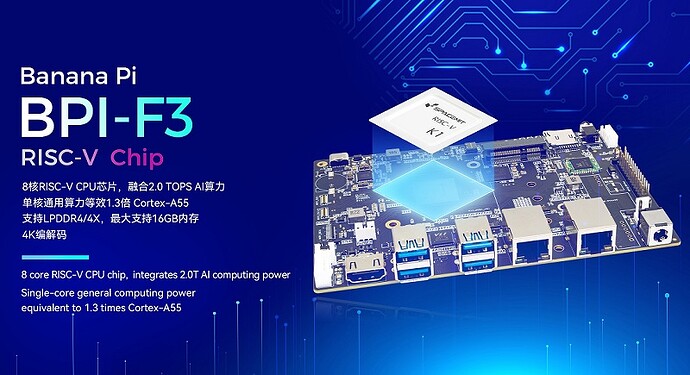K1 is an octa-core 64-bit RISC-V AI CPU.
Base on RISC-V open instruction set architecture,we are committed to create more energy efficient and more commonly used AI processor platform,promote global open source and open ecological computing power construction.
K1 is mainly used for single board computer,network storage,cloud computer,smart robort,industrial control,edge computer,etc.
Excellent CPU Performance
Octa-core RISC-V AI CPU,provided 50KDMIPS CPU computing power and 2.0 TOPS AI computing power.The computing power for single core in K1 is 30% ahead of ARM A55.
Powerful Vector Computing Power
The world’s first RISC-V AI CPU supports RVA22 Profile and 256-bit RVV 1.0 standard, provides 2 times SIMD parallel processing capability than Neon.
General AI Computing Power
Provides AI computing power by CPU core fusion,achieve rapid integration with all mainstream AI ecosystems.
Leading Computing Power Efficiency
Lean and superior micro-architecture,the computing power efficiency is 20% higher than A55.
Rich IO Capabilities
Integrates multiple interfaces including PCIe,USB,GMAC,SPI,etc,provides comprehensive selection of peripheral connections.
Meet industry standards
CPU can provide stable continuous power output under temperatures from -40 degree to -85 degree,which can meet the demanding needs of industrial applications.
KEY STONE K1 RISC-V AI CPU Features
Processor
K1 is an octa-core X60™ intelligent computing processor
Eight-stage dual-issue in-order pipelin
Supports 256-bit RVV1.0 standard.
CPU combines 2.0 TOPS AI computing power.
1MB of shared L2 Cache for every eight cores.
Integration of RISC-V and AI techonology
X60TM extends 16 AI instructions, including matrix multiplication and sliding window calculation.
It’s an open system with instruction sets and operator libraries that can run all AI algorithm from AlexNet to Llama-2-7b.
Follows the development method of general-purpose CPUs, a programming model can cover the entire process of AI development.
Security Architecture
Supports RISC-V PMP security specifications and ePMP security extensions.
Supports secure boot, secure storage, signature verifications.
Supports algorithms like AES, SHA, RSA, SM2, SM3, SM4,etc.
Supports product lifecycle security management.
Memory
32bit LPDDR4 - 2400MT
32bit LPDDR4X - 2666MT
Max to 16 GB.
Bandwidth max to 10.6GB/s
Storage
Supports SPI flash
Supports eMMC 5.1
Supports SDIO3.0 SD card.
Supprts SSD:NVMe over PCle
Multimedia and Display
Supports 3D graphics engine,compatibility with OpenCL 3.0, OpenGLES 3.2, Vulkan 1.2
Supports 4K H.265/H.264/VP9/VP8, and other encoding/decoding formats.
Dual-screen display support, with a maximum resolution of 1920*1440@60fps.
-By MIPI-DSI,HDMI output.
Supports triple camera inputs, with a single camera of up to 16MP.
Supports stereo sound output.
Interface
5×PCIe2.1(Combination of x2+x2+x1,5Gbps/Lane)
1×USB3.0(Combo PCIe2.1 x1)
2×USB2.0(OTG + Host)
2×GMAC(RGMII&1000M)
4×SPI、7×I2C、12×UART、2×CAN-FD、30×PWM
Operation Systems
Bianbu OS
Linux(Mainstream distribution versions)
RTOS
Package
Package type:FCCSP
Pin pitch:0.65mm
Power Consumption
TDP: 3~5W
Banana Pi BPI-F3 documents : Banana Pi BPI-F3 | BananaPi Docs
